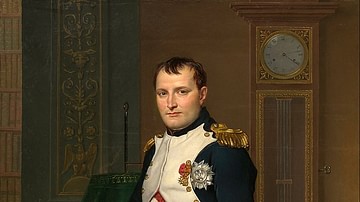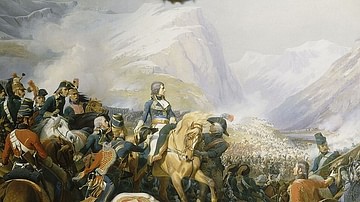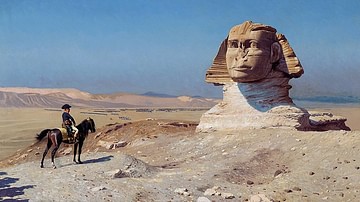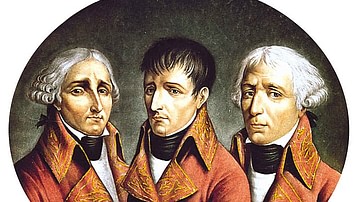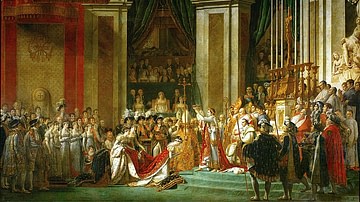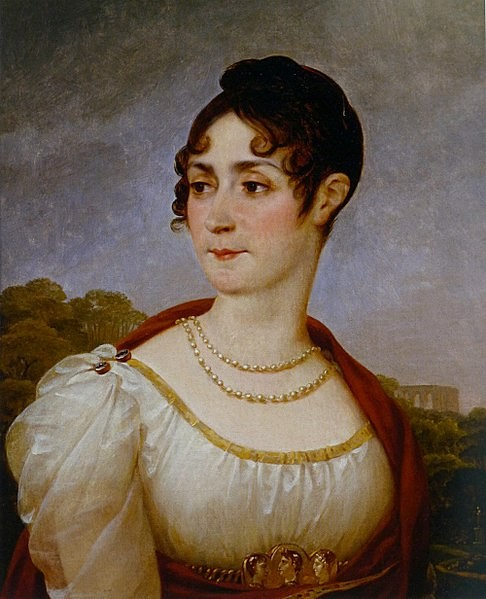
Joséphine de Beauharnais (1763-1814) was a French noblewoman who was the first wife of Napoleon Bonaparte (1769-1821). She was therefore Empress of the French from 18 May 1804 until the annulment of her marriage on 10 January 1810, as well as Queen of Italy from March 1805 until 1810.
Born on a sugar cane plantation in the French colony of Martinique, Joséphine married French viscount Alexandre de Beauharnais in late 1779 and moved with him to Paris. The couple had a rocky marriage that produced two children. During the French Revolution (1789-1799), Beauharnais was imprisoned and executed; Joséphine herself came close to being guillotined, but her life was spared with the end of the Reign of Terror. In March 1796, she married General Napoleon Bonaparte, becoming Empress of the French when her new husband proclaimed the First French Empire in May 1804.
As empress, Joséphine was known for her sophistication and fashion sense; she commissioned artworks from many famous artists and helped pioneer the 'Empire style' design movement. When it became clear that Joséphine could not produce an heir, Napoleon annulled the marriage in January 1810. Joséphine died of pneumonia four years later. Despite her inability to provide Napoleon with an heir, several of her descendants through her first marriage became prominent historical figures; her most famous descendent was her grandson, Louis-Napoleon Bonaparte, who would one day rule over the Second French Empire as Napoleon III (r. 1852-1870).
It is important to note that Joséphine never went by the name 'Joséphine de Beauharnais' in her own lifetime. Prior to meeting Napoleon, she was known by her birth name, Marie-Rose; Napoleon bestowed the name Joséphine on her, perhaps derived from her middle name Josèphe. After her marriage to Napoleon, she went by Joséphine Bonaparte; however, historians from the Bourbon Restoration era did not want to refer to her using Napoleon's surname and resorted to calling her Joséphine de Beauharnais, the name she is most commonly known by today.
Early Life
The woman best known to history as Joséphine de Beauharnais was born Marie Josèphe Rose Tascher de La Pagerie on 23 June 1763, on the Caribbean island of Martinique. She came from a family of French country gentry that had originated in the Loire valley. Her family first came to Martinique in 1726 when her grandfather, Gaspard Tascher, decided to seek his fortune through a sugar cane plantation. However, a series of misfortunes including hurricanes and Gaspard's own ineptitude prevented him from prospering. In 1752, Gaspard secured a position as a page for his son, Gaspard-Joseph, in the court of King Louis XV of France (r. 1715-1774). Gaspard-Joseph served in this position for three years before returning to Martinique, where he took over the struggling plantation from his father and served as a sub-lieutenant in the local militia. In 1761, Gaspard-Joseph married Rose-Claire des Vergers des Sannois, the daughter of one of the oldest families in Martinique; as a dowry, Gaspard-Joseph received the plantation of Les Trois-Îlets, just south of Martinique's capital of Fort-Royal.
It was on this plantation that the future French empress was born in 1763. Joséphine, who initially went by the name Marie-Rose, spent her earliest years amidst the plantation's sugar cane and tobacco fields and amongst the families of her father's slaves. She was raised by an enslaved nurse named Marion, who affectionately cared for the young Joséphine; years later, Joséphine would purchase Marion's freedom. During her childhood, Joséphine's main companions were her two younger sisters, Catherine-Désirée (b. 1764) and Marie-Françoise (b. 1766). In 1773, Joséphine and Catherine-Désirée were sent to a boarding school in Fort-Royal where they received a meager education and learned how to write, sing, dance, and embroider, but little else. In October 1777, Catherine-Désirée suddenly died of a fever, and the 14-year-old Joséphine moved back to Les Trois-Îlets to comfort her bereft mother.
Around this time, François de Beauharnais, a wealthy French naval officer and former governor of Martinique, was looking for a bride for his son, Alexandre. Born in Martinique in 1760, Alexandre de Beauharnais had lived with the Tascher family for five years as an infant, having been judged too young to accompany his parents to France; he and Joséphine had therefore spent parts of their childhoods together. Partially for this reason, and partially because his mistress was Joséphine's paternal aunt, François de Beauharnais decided to betroth his son to one of the Tascher girls. Initially, it was decided that Alexandre would marry Catherine-Désirée, but after her untimely death in 1777, he was betrothed to Joséphine instead. In October 1779, Joséphine accompanied her father to Paris, where she married Alexandre two months later. The couple remained in Paris and soon had two children: a boy, Eugène de Beauharnais, was born on 3 September 1781, while a girl, Hortense de Beauharnais, was born on 10 April 1783.
During the Terror
The marriage between Alexandre de Beauharnais and Joséphine (or 'Rose' as he would have known her) was an unhappy one. As a properly educated gentleman, Alexandre was embarrassed by Joséphine's provincial manners and lack of sophistication; whenever he attended social events, he would always leave her behind. The relationship quickly became abusive; Alexandre would regularly beat Joséphine and once even kidnapped three-year-old Eugène from the convent where Joséphine had gone to escape his abuse. Alexandre was constantly unfaithful, visiting brothels and even abandoning his family for stretches at a time to live with his mistresses. In March 1785, Joséphine was able to obtain a separation from her husband. She remained in Paris for three years, during which time she adapted to Parisian high society, procuring fashionable dresses and jewelry. In 1788, she briefly moved back to Martinique but was forced to return to Paris in 1790 due to a slave revolt.
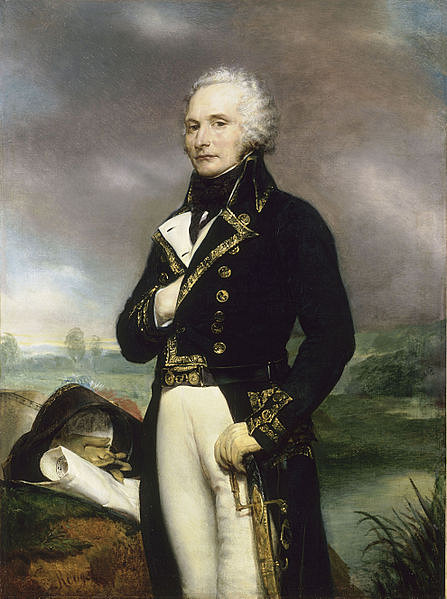
By this point, the French Revolution was in full swing. Alexandre de Beauharnais had played an active role in its early stages; he had been elected to the Estates-General of 1789 as a deputy of the nobility and had been one of the first nobles to take up the cause of the Third Estate (commoners). He had enthusiastically supported the abolition of feudal privileges in the August Decrees and became an officer in the French revolutionary army. However, despite Alexandre's support of the Revolution, he was still an aristocrat, a fact that automatically placed him under suspicion of counter-revolution during the Reign of Terror. After the radical Jacobins accused Alexandre of having commanded poorly during the Siege of Mainz (14 April to 23 July 1793), he was arrested on 2 March 1794. Despite his previous abuses, Joséphine defended her husband; for this, she, too, was arrested on 22 April.
Joséphine would spend the next three horrifying months as a prisoner of the Jacobin regime, kept in the damp and dark crypt beneath the Church of Saint-Joseph-des-Carmes. The torturous conditions she faced during her imprisonment are noted by historian Andrew Roberts:
Air came only from three deep holes to the underground cells and there were no lavatories; she and her cellmates lived in daily fear of the guillotine; they had one bottle of water a day each, for all uses; and since pregnant women weren't guillotined until after giving birth, the sound of sexual couplings with the warders could be heard in the hallways at night. It is cold down in the Saint-Joseph crypt even in midsummer, and inmates' health broke down fast, indeed it is possible that Josephine survived only because she was too ill to be guillotined (Roberts, 69).
Alexandre de Beauharnais was guillotined on 23 July 1794, just four days before the fall of Maximilien Robespierre ended the Terror. Joséphine was subsequently released from prison, having narrowly escaped death; if Robespierre's regime had lasted even a month longer, it is likely that Joséphine would have been executed as well. After her release, Joséphine became sexually promiscuous, seducing powerful French officials and indulging in luxury and fashion. Roberts suggests that this was, at least partially, an expression of post-traumatic stress disorder, an urge to find a protector amongst France's most powerful men.
She had an affair with the dashing General Lazare Hoche who refused to leave his wife for her. She then moved on to Paul Barras, one of the leading figures in the new revolutionary government, the French Directory. Her affair with Barras lasted for the summer of 1795, but the serial womanizer soon grew tired of her company and sought to pass her off to someone else. He decided to introduce her to the young, up-and-coming general Napoleon Bonaparte.
Marriage to Napoleon
When they met, Napoleon was 26 and Joséphine was 32. She was beautiful and charming and spent a lot of time perfecting her make-up and clothing. Her smile was often close-lipped, an attempt to hide her blackened teeth that were likely the result of chewing on sugar cane as a child. Joséphine was not much impressed by the scrawny, unkempt young officer; however, she was deeply in debt and saw the advantage of a marriage to Napoleon who had just been named commander of the Army of Italy.
Likewise, Napoleon was attracted to Joséphine partially because she was well-connected in Paris' high society. But unlike Joséphine, Napoleon seemed to actually have been smitten; only two months after meeting, he began sending her romantic letters: "what a strange effect you have on my heart! I draw from your lips, from your heart, a flame that burns me" (Bell, 22). He began calling her 'Joséphine', the name that she would use for the rest of her life. On 9 March 1796, the couple were married in a civil ceremony, the bride wearing a tricolor revolutionary sash over her muslin dress. Two days later, Napoleon left Paris to take command of the Army of Italy.
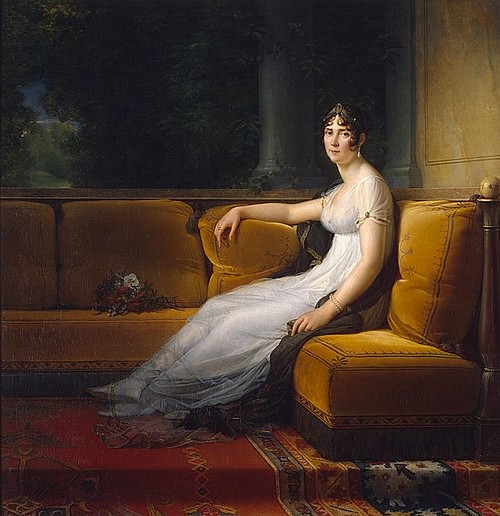
Napoleon's Italian campaign of 1796-1797 was a success, launching the young general into political superstardom and cementing his reputation as a military genius. Throughout the campaign, he kept a portrait of Joséphine, which he habitually kissed and showed off to his officers, believing it brought him luck. He wrote to Joséphine almost daily, his letters passionate to the point of melodrama: "the thought of you has taken precedence of all else in my soul…beautiful you are, gracious; a sweet, a celestial soul expresses itself in heavenly tints on your face" (Roberts, 102). Joséphine, however, rarely wrote back, and when she did, her replies were short and passionless. Indeed, while Napoleon was in Italy, Joséphine began an affair with Hippolyte Charles, a young and handsome hussar lieutenant.
In 1798, during Napoleon's Campaign in Egypt and Syria, the general learned of Joséphine's affair. Enraged, he began an affair of his own with Pauline Fourès, the wife of a junior officer who became known as 'Napoleon's Cleopatra'. When Napoleon returned to Paris in October 1799, he and Joséphine confronted one another about their infidelities, leading to a dramatic shouting match in the street; Napoleon went so far as to pack his bags but was stopped from leaving by the intervention of Joséphine's children. He and Joséphine reconciled. Over time, Joséphine came to love Napoleon in her own way, although she always referred to him as 'Bonaparte'; Napoleon seems to have still loved Joséphine, though some of the passion had faded. After Charles broke off the affair with Joséphine, she never took another lover, while Napoleon went on to have many more mistresses.
Empress of the French
In November 1799, Napoleon seized control of the French government in the Coup of 18 Brumaire. Four years later, he proclaimed himself emperor of the French and crowned Joséphine as empress during a ceremony at the Notre-Dame de Paris Cathedral on 2 December 1804. In March 1805, Napoleon added King of Italy to his steadily growing list of titles, and Joséphine became Queen of Italy. Napoleon also elevated his stepchildren to high positions within the new French Empire; Eugène de Beauharnais was appointed Viceroy of the Kingdom of Italy in 1805 and was often entrusted with important commands during the Napoleonic Wars (1803-1815). Napoleon and Joséphine would eventually secure Eugène's marriage to Princess Augusta, daughter of the king of Bavaria. Hortense de Beauharnais had married Napoleon's brother, Louis Bonaparte, in 1802; though their marriage was unhappy, Hortense became a queen in 1806 when Napoleon granted Louis the Kingdom of Holland. Hortense and Louis would have three children, including the future French Emperor Napoleon III (l. 1808-1873); Napoleon III was therefore both Joséphine's grandson and Napoleon's nephew.
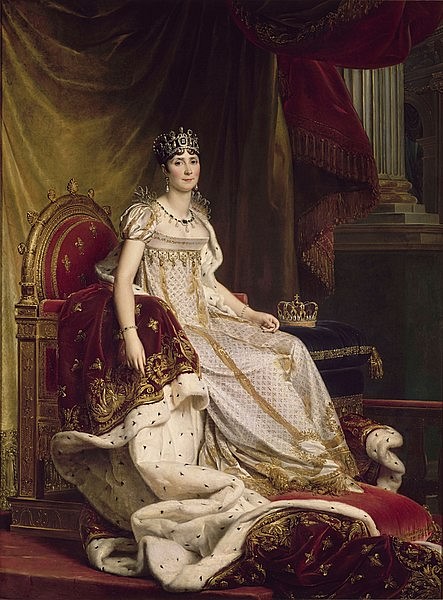
As Napoleon was off conquering Europe, Joséphine remained in Paris where she became one of the most fashionable and sophisticated women in the empire. She was a central figure in the emergence of the neoclassical 'Empire style' of design that influenced furniture and architecture during the Napoleonic period. She encouraged the ostentatious styles that had flourished during the days of Louis XIV of France (r. 1643-1715) and brought lavish tapestries and bronzes out of storage to decorate the Tuileries Palace. She would host dinners for 200 people every ten days at the Tuileries and reimplemented pre-revolutionary court etiquette. Her personal residence, the Château de Malmaison, was decorated with Pompeian frescoes and littered with neoclassical works of art; it included 300 acres of gardens and woods and housed a menagerie of kangaroos, emus, and other exotic animals. Joséphine was also a great patron of the arts and commissioned works from famous artists such as Jacques-Louis David, François Gérard, and Antoine-Jean Gros. She commissioned four major artworks from the Italian sculptor Antonio Canova, including the 'Three Graces', a neoclassical statue depicting the three Charites, representations of youth, mirth, and elegance.
Joséphine was certainly the model of elegance in France, to the chagrin of Napoleon's three jealous sisters. This came at a price, however; Joséphine's fashionable dresses and luxurious furniture eventually ran up a bill higher than anything Marie Antoinette (1755-1793) had spent.
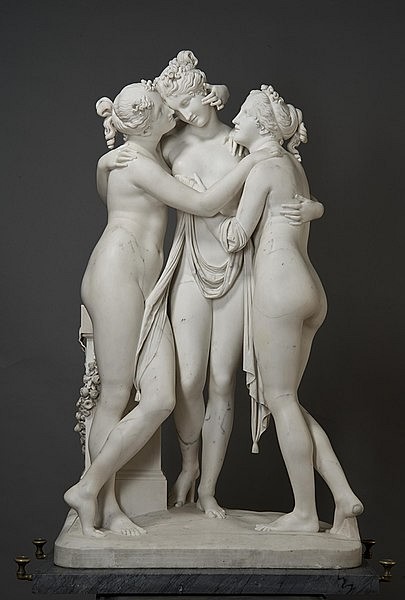
Annulment & Death
By 1809, Joséphine had failed to give Napoleon a child, a fact that had put a major strain on their marriage. Napoleon believed that he needed a son in order to ensure the survival of his dynasty, but after 13 years of trying, it was becoming clear that the 46-year-old Joséphine was unlikely to have any more children. On 30 November 1809, Napoleon told Joséphine over dinner that he had made the difficult decision to annul their marriage. "You have children," he told her, "I have none. You must feel the necessity that lies upon me of strengthening my dynasty" (Roberts, 536). Joséphine apparently burst into tears and begged him to reconsider; Napoleon would later recall that she "gave a scream and fainted" (ibid). The annulment was finalized on 16 December, and on 10 January 1810, a divorce ceremony was held, during which each party read a statement of devotion to the other.
Napoleon allowed Joséphine to retain the title of 'empress' and let her keep the Château de Malmaison, where she lived from then on. She was also created the Duchess of Navarre. Napoleon, meanwhile, was married by proxy to Marie Louise of Austria, daughter of the Austrian emperor, on 11 March 1810. A year later, Marie Louise gave birth to a son, Napoleon II, who was styled as the King of Rome. Throughout all this, Napoleon and Joséphine remained on good terms; some claim that they were still in love, although it is impossible to know for certain.
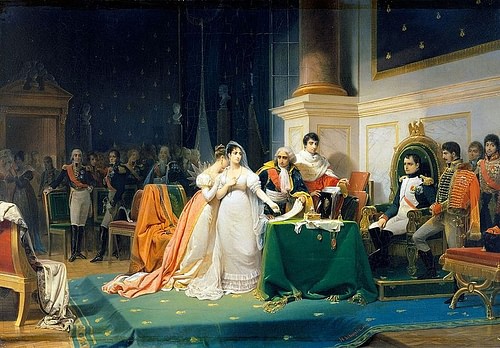
In April 1814, Napoleon was forced to abdicate his throne after being defeated in the War of the Sixth Coalition. He was exiled to the island of Elba while the Bourbon King Louis XVIII of France ascended the throne. Joséphine continued to live lavishly at Malmaison, where she held dinners and ostentatious balls. After one such event, she went walking in the cold night air with Tsar Alexander I of Russia (r. 1801-1825), with the latter promising her his protection. However, Joséphine came down with pneumonia and died five days later at noon on 29 May 1814, aged 50. When Napoleon was told of her death, he merely remarked, "Ah! She is happy now" (Roberts, 724).
Although Joséphine was no longer Empress of the French at the time of her death, several of her descendants were members of European royalty. Her most famous descendent was her grandson through Hortense, Napoleon III, who ruled over the Second French Empire (1852-1870). One of her granddaughters through Eugène, Amélie of Leuchtenberg, became Empress of Brazil when she married Pedro I of Brazil in 1829. Another of Eugène's daughters, also named Joséphine, would go on to marry King Oscar I of Sweden; through this marriage, Joséphine is the direct ancestor of the current heads of the royal houses of Sweden, Norway, Belgium, and Denmark. Several of Joséphine's jewels are also worn by present-day royals. Today, Joséphine continues to capture the popular imagination; she was portrayed many times in film and television, most notably by Italian actress Isabella Rossellini in the 2002 miniseries Napoléon, and by English actress Vanessa Kirby in Ridley Scott's 2023 film Napoleon.

